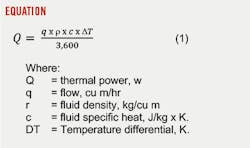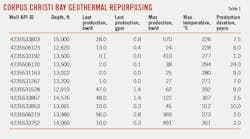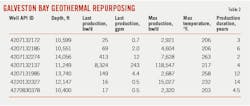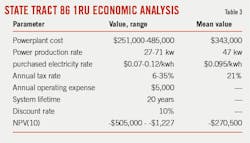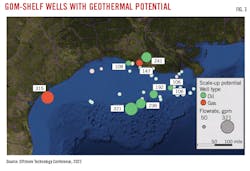Based on “New Life for Old Offshore Platforms – Where is Geothermal an Option?,” OTC-32053-MS, Offshore Technology Conference, Houston, Tex., May 2-5, 2022 and “Geothermal gradients of the northern continental shelf of the Gulf of Mexico,” Geosphere, Vol. 12, No. 1, Feb. 1, 2016, pp. 26-34.
Energy can be extracted from decommissioned wells in the US Gul fo Mexico (GOM) based on typical offshore geothermal gradients, but most wells lack required water production for electricity conversion. Unconventional geothermal approaches could address this issue and open more wells for conversion based on geothermal maps of the US GOM Continental shelf.
Researchers from Petrolern LLC and Sabata Energy Consultants LLC examined GOM wells for potential conversion to conventional geothermal energy generation as an alternative to decommissioning based on typical geothermal gradients in the GOM.
Corpus Christi Bay and Galveston Bay wells and platforms had the highest likelihood of being able to sell power onshore if geothermal is viable. Selected wells from these areas were evaluated for geothermal power generation based on local geothermal gradient and existing well conditions. Included in the analysis were energy costs and project financials.
Results of the study showed that power could be created from a few wells, but water flow rates were too low in most wells for sustained electricity production
Geologic considerations
GOM geopressured systems with associated geothermal resources were created by sedimentation rates in the 3-15 cm/year range, about 6-30x typical world average rates. A geopressured zone exists along the northern GOM basin where deep geopressured tertiary sands are confined by shale beds. The Frio formation along the Texas Gulf Coast contains hot brine in porous aquifers at 3-6 km depth where water temperatures range from 90-200° C. Wells within Corpus Christi and Galveston Bay are predominantly in the Frio formation but not necessarily in optimum locations for geothermal production.
Previous Gulf Coast basin studies of Wilcox (onshore) and Frio formations (offshore) led the Department of Energy to fund a pilot program for geothermal production in the basin. From 1989 to 1990, the Pleasant Bayou No. 2 well generated power in an extended production test.
Later geothermal assessments for the GOM defined thermal characteristics of the continental shelf (Fig. 1). The dashed black line outlines the edge of the continental shelf. Dashed white lines outline Isopachs of Pleistocene sediments. The general trend of the Corsair growth fault zone is shown as green lines. Highest offshore shelf gradients were along the Texas coast into Louisiana where gradients then declined, except for a patch south of Lafayette and a smaller gradient rise west of the Mississippi Delta.
Geothermal modeling
Shelf wells in Corpus Christi and Galveston Bays were selected for study due to their minimal distance to onshore electrical infrastructure. Well flow rates, production ratios, and bottom hole temperatures were obtained from the Texas Railroad Commission. Where temperature data were unavailable, bottom hole temperatures were calculated from the geothermal gradient. Long-term production estimates used decline curves to predict flow rates and pressures for an additional 30 years. Geothermal gradients came from the Southern Methodist University Geothermal Laboratory node of the 2014 National Geothermal Data System (NGDS) database.
Initial well selection was by depth, identifying wells which had minimal depth at the 100° C. required minimum reservoir temperature for thermal power generation. A secondary screening added a 10,000 bw/d minimum flow rate requirement.
Produced thermal energy from a well is calculated from Equation 1. The study used a program from ElectraTherm Inc. to calculate well power potential using wellhead flow rate and temperature. Electrical power potential estimates used standard resource recovery factors and power-plan conversion efficiency values. The program calculates estimated power generation (in kw) for ElectraTherm’s proprietary binary organic Rankine cycle (ORC) power system which converts water into steam, then expands that steam through a turbine to produce mechanical work.
The tool can analyze thermal fluid intake between 70-150° C. and flow rates between 3,250-12,500 bw/d. The publicly available version of the tool does not include additional parameters which could optimize power production such as working fluid type, heat exchanger elements, cooling system design, cooling system fluid flow rate, and other design parameters.
Net present value (NPV) and internal rate of return (IRR) estimated project economics for a system life of 20 years. NPV is the sum of annual cash flows discounted by 10% (NPV(10)), and IRR is the discount rate that zeros out NPV. Input for the analysis included net power generation rate, capital expenses, startup costs, annual operating expenses, and annual income. Other expenses included taxes and depreciation. The model also calculated breakeven time.
Scaling up the potential of geothermal power used statistical analysis of the number of platforms, target formations, and production rates along the Gulf Coast. Wells included in the scale-up analysis had total depths greater than 11,000 ft, bottom hole temperatures of about 107° C., and flow rates greater than 50,000 bbl/month in the last month of production. Only wells within the higher thermal regime of the GOM and on the continental shelf with less than 1,000 ft water depth were considered for the scalability assessment.
Well power-production analysis
Gradients in Corpus Christi Bay are about 40 °C./km and wells have average 13,500 ft total depth. Eleven wells were selected from Corpus Christi Bay for geothermal electricity production analysis based on water production and temperature data (Table 1).
The wells do not sustain the 10,000 bw/d rate required for commercial geothermal energy production, producing 1,000-10,000 bbl/month. The ElectraTherm calculator tool is limited to fluid temperatures of 70-150° C. and flow rates of 95-364 gpm, therefore wells with sufficient temperatures in Corpus Christi Bay have flow rates too low for geothermal electricity production.
Only seven Galveston Bay wells could be considered for geothermal electricity generation (Table 2). The geothermal gradient is between 28-32° C./km, which is lower than in Corpus Christi Bay, but the wells were sufficiently deep to reach required temperatures of 96-128° C. The wells within Galveston Bay also produced water with rates sufficient to generate electricity. Using the ElectraTherm calculator, State Tract 86 1RU (API well 42071321370000) could generate between 30-65 kW using its latest reported water production rate. This was the only well at end-of-life with sufficient flow rate for electricity production, with all other wells under 500 bw/d.
A 30-65 kW power system will generate about 262-569 Mwh/year which is not enough to maintain stand-alone power but can support hydrocarbon production (platform power, artificial lift systems, etc.) or reduce the amount of purchased energy.
The project has a negative NPV(10) given reasonable ranges of purchased electricity rates, power production rates, power plant costs, and annual tax rates (Table 3). The levelized cost of electricity (LCOE) ranged from $0.028-$0.047 at the low end of the power plant cost range and $0.074-$0.124 at the high end. Power plant cost and power production rate were the most significant drivers of uncertainty in the analysis.
Wells producing above 80 kw and power plant costs below $320,000 are required to produce positive NPV(10). Power purchase costs as high as $0.10/kwh would result in a discounted payback in 13.3 years, NPV(10) of about $83,000, and IRR of 14%.
GOM geothermal potential
Water flow rates are critical for repurposing GOM wells and offshore platforms for conventional geothermal energy. The Corpus Christi Bay and Galveston Bay study revealed several wells with sufficient bottom hole temperatures, but without enough water flow rates to support electricity production. Considering these limitations, the well repurposing market within the US GOM continental shelf was determined by examining wells with bottom hole temperatures of at least 100° C. and water flow rates greater than 50 bpm (Fig. 3). Up to 46 wells were found that matched the minimum requirements, with 13 that could be operated with the ElectraTherm ORC which requires a minimum 95 bpm flow rate.
The study did not consider unconventional enhanced geothermal systems (ESG) where water or other working fluid is pumped into the well to return as heated fluid or gas (OGJ, June 6, 2022). Injecting working fluids into the well eliminates the minimum water production requirement and adds more wells for geothermal generation consideration but requires significant additional expenses in equipment and well completion redesign.

Alex Procyk | Upstream Editor
Alex Procyk is Upstream Editor at Oil & Gas Journal. He has also served as a principal technical professional at Halliburton and as a completion engineer at ConocoPhillips. He holds a BS in chemistry (1987) from Kent State University and a PhD in chemistry (1992) from Carnegie Mellon University. He is a member of the Society of Petroleum Engineers (SPE).


